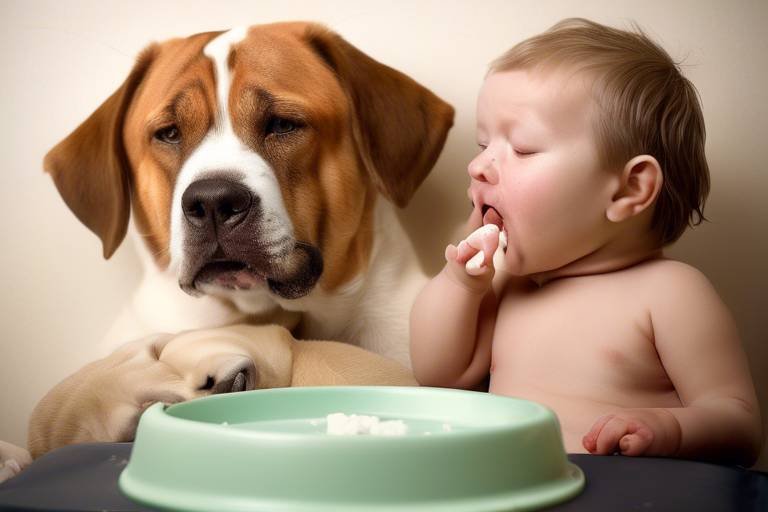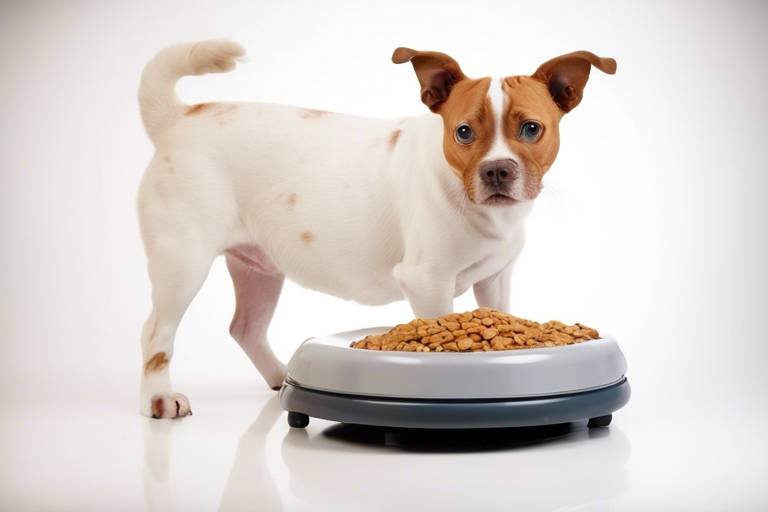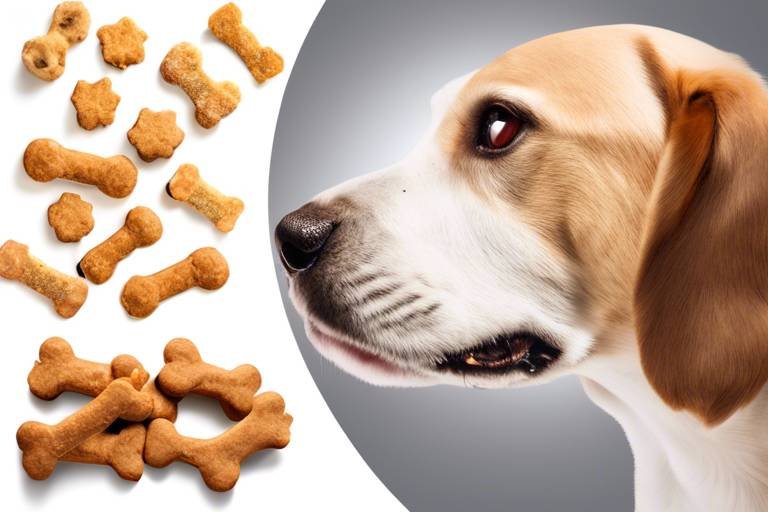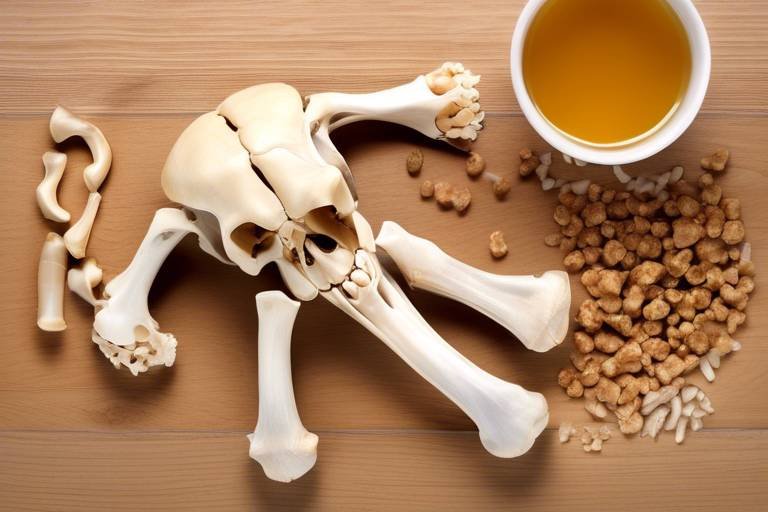Understanding the Effects of Overfeeding Pets
As pet owners, we all want the best for our furry companions. However, in our quest to show love and affection, we sometimes fall into the trap of overfeeding. This seemingly harmless act can lead to a myriad of issues for our pets, both physically and mentally. Just like humans, pets can suffer from the consequences of an unhealthy diet, and understanding these effects is crucial for responsible pet ownership.
Overfeeding pets can lead to serious health risks, including obesity, diabetes, and joint problems. Imagine your pet as a balloon; when you keep adding air, it expands. But what happens when it expands too much? It can pop! Similarly, when pets are overfed, their bodies can struggle to cope with the excess weight, leading to a range of health complications. For instance, obesity is not just about looking cute; it can severely shorten a pet's lifespan and lead to chronic conditions that require ongoing veterinary care.
Moreover, the health implications of overfeeding go beyond just weight gain. Conditions like diabetes can develop when pets consume too many calories without sufficient exercise. This not only affects their physical health but can also impact their quality of life. Imagine a once-active dog that now struggles to keep up with a simple walk; it’s heartbreaking for both the pet and the owner.
In addition to the physical ramifications, overfeeding can also trigger behavioral changes in pets. Pets that are overfed may display lethargy, aggression, or even anxiety. It’s as if their bodies are constantly in a state of discomfort, leading to irritability. Recognizing these signs is essential; after all, a happy pet is a healthy pet. If you notice that your pet is more irritable or less playful, it might be time to reassess their diet.
So, how do we prevent these issues from arising? The first step is understanding the importance of portion control. Just as we wouldn’t want to eat an entire pizza in one sitting, pets also benefit from regulated meal sizes. Knowing the right portion sizes for different breeds and ages is vital. For example, a small breed dog requires significantly less food than a large breed dog. This knowledge empowers owners to make informed decisions about their pets' diets and nutritional needs.
Establishing a consistent feeding routine is another effective measure. Pets thrive on routine, and a well-structured schedule can help regulate their appetite and prevent overeating. By feeding your pet at the same times each day, you help them understand when to expect their meals, which can lead to better behavior and a healthier lifestyle.
In conclusion, understanding the effects of overfeeding is essential for maintaining your pet's health and happiness. By being mindful of portion sizes and establishing a feeding routine, you can help your furry friend lead a long and fulfilling life. Remember, a healthy pet is a happy pet!
- What are the signs that my pet is being overfed? Look for symptoms such as weight gain, decreased energy, and a fixation on food. If your pet seems to be constantly hungry or is gaining weight rapidly, it may be time for a dietary adjustment.
- How can I determine the right portion size for my pet? Consult with your veterinarian to establish the appropriate portion sizes based on your pet's breed, age, and activity level. This will help ensure they receive the right amount of nutrition without excess calories.
- Can overfeeding affect my pet's behavior? Yes! Overfeeding can lead to lethargy, aggression, and anxiety in pets. A balanced diet promotes better behavior and overall well-being.
- What are some healthy alternatives to treats? Instead of sugary snacks, consider offering fruits like apples or carrots as treats. Always check with your vet before introducing new foods to ensure they are safe for your pet.

The Health Risks of Overfeeding
Overfeeding pets is not just a matter of spoiling them; it can lead to serious health issues that can drastically affect their quality of life. One of the most alarming consequences of overfeeding is obesity. Just like in humans, excess weight can put a strain on a pet's body, leading to a host of health problems. Obesity is often the gateway to other serious conditions such as diabetes, heart disease, and joint problems. Imagine carrying around an extra 20 pounds every day; that’s what our furry friends endure when they are overfed.
Let’s break it down a bit. When pets consume more calories than they burn, the excess energy is stored as fat. This can lead to a vicious cycle; as pets gain weight, they become less active, which means they burn even fewer calories. It’s a bit like a snowball rolling downhill, gaining size and speed as it descends. According to the Association for Pet Obesity Prevention, an estimated 60% of cats and 56% of dogs in the U.S. are classified as overweight or obese. These figures are staggering and highlight the urgent need for pet owners to be vigilant about their pets' diets.
In addition to obesity, overfeeding can also lead to diabetes. This condition occurs when the body becomes resistant to insulin, making it difficult to regulate blood sugar levels. Pets that are overweight are at a significantly higher risk of developing diabetes, which can lead to a lifelong dependency on medication and frequent vet visits. Moreover, diabetes can cause symptoms such as excessive thirst, frequent urination, and lethargy, which can severely diminish a pet's quality of life.
Another serious health risk associated with overfeeding is the development of joint problems. Excess weight puts additional stress on a pet’s joints, leading to conditions such as arthritis. Imagine trying to walk with a heavy backpack; that’s what our pets feel every time they take a step when they are overweight. This can result in chronic pain, decreased mobility, and a general decline in their overall well-being. Pets with joint issues often struggle with simple activities like climbing stairs or playing fetch, which can lead to frustration and behavioral problems.
To illustrate these risks further, here’s a quick comparison of the health issues related to pet obesity:
| Health Issue | Description | Potential Consequences |
|---|---|---|
| Obesity | Excess body weight | Heart disease, diabetes, joint problems |
| Diabetes | Insulin resistance | Frequent vet visits, medication dependency |
| Joint Problems | Increased pressure on joints | Arthritis, chronic pain, reduced mobility |
As responsible pet owners, it's crucial to monitor our pets’ diets closely. A little extra food here and there might seem harmless, but the long-term effects can be devastating. By understanding the health risks of overfeeding, we can make informed decisions that promote a healthy lifestyle for our pets. Remember, a happy pet is a healthy pet!

Behavioral Changes in Overfed Pets
When it comes to our beloved pets, we often think about their physical health, but what about their behavioral well-being? Overfeeding can lead to a variety of behavioral changes that might surprise even the most seasoned pet owners. Imagine your once playful pup turning into a couch potato, or your curious cat suddenly becoming irritable. These transformations are not just coincidental; they are often linked directly to the amount of food we give them.
One of the most noticeable changes in overfed pets is a tendency towards lethargy. Pets that are constantly stuffed with food may lack the energy to engage in their usual playful antics. Instead of chasing after toys or exploring the backyard, they might prefer to lounge around, leading to an unhealthy cycle of inactivity and weight gain. This lethargy can also affect their social interactions with other pets and even with humans, making them less inclined to join in on family activities.
On the flip side, some pets may exhibit increased aggression when overfed. You might think that a well-fed pet would be content, but overfeeding can lead to irritability and mood swings. Just like humans, pets can become cranky when they feel uncomfortable in their own bodies. This change in temperament can lead to unexpected conflicts, especially in multi-pet households where food competition is a factor. Recognizing these behavioral shifts is crucial for maintaining harmony at home.
Now, let’s dive deeper into the connection between diet and behavior. A pet's diet is not just about nutrition; it's a cornerstone of their emotional stability. When pets consume an unbalanced diet, it can lead to irritability and hyperactivity. For instance, a diet high in processed foods and low in essential nutrients can create a rollercoaster of energy levels. This instability affects their overall temperament and can strain the relationship between pets and their owners.
Speaking of diets, let’s talk about sugary foods. You might think it’s harmless to share a piece of cake or a sugary snack with your furry friend, but these treats can lead to significant behavior changes. Pets that indulge in sugary delights often experience hyperactivity followed by crashes, much like a child on a sugar high. This cycle can result in mood swings and even anxiety, making it essential for pet owners to be mindful of what they feed their pets.
Interestingly, overeating can sometimes be a response to anxiety in pets. Just like some people might reach for comfort food during stressful times, pets may turn to food as a coping mechanism. Identifying the root cause of this behavior is crucial. Is your pet anxious due to changes in their environment, or are they simply bored? Understanding these triggers can help owners address both the emotional and physical health of their pets.
So, how do you know if your pet is being overfed? It’s important to keep an eye out for various signs that indicate your furry friend may need a dietary adjustment. Symptoms such as weight gain, decreased energy, and even an obsession with food can signal that your pet is being overfed. By recognizing these symptoms early, pet owners can take action to improve their pets' health and overall quality of life.
Link Between Diet and Behavior
Have you ever noticed how your pet's mood can change just like the weather? It turns out, there's a significant connection between a pet's diet and its behavior. Just like us, our furry friends are affected by what they eat. An unbalanced diet can lead to irritability, hyperactivity, or even lethargy, which can create a ripple effect on their overall temperament and their relationship with you. Imagine trying to have a conversation with a friend who just downed a dozen donuts—it's likely they would be bouncing off the walls! Well, the same can happen with our pets.
For instance, pets that consume a diet high in processed foods and sugars may display signs of hyperactivity. You might see them zooming around the house, unable to settle down. This behavior can be frustrating for owners who just want a calm companion. On the flip side, a diet lacking in essential nutrients can lead to lethargy and disinterest in play or interaction. It's like trying to run a marathon on an empty stomach—there’s just no energy to keep going!
Additionally, the types of food we offer can impact not just the physical health of our pets but also their emotional well-being. For example, a diet rich in omega-3 fatty acids can promote a more relaxed demeanor, while an excess of sugary treats can lead to mood swings. Consider this: if you were constantly fed junk food, how would you feel? Probably not your best self! The same applies to our pets.
To help you understand this connection better, here’s a simple table that outlines the effects of different types of diets on pet behavior:
| Type of Diet | Potential Behavioral Effects |
|---|---|
| High in Sugars | Hyperactivity, Mood Swings |
| Low in Nutrients | Lethargy, Disinterest |
| Balanced Diet | Stable Mood, Increased Energy |
In summary, being mindful of your pet's diet is crucial not only for their physical health but also for their emotional stability. Just like you wouldn’t want to fuel your body with junk, your pet deserves nutritious meals that keep them happy and balanced. So next time you’re at the pet store, think about what you’re putting in that cart!
In light of these insights, it’s essential to monitor your pet’s diet closely. If you notice any behavioral changes, take a moment to evaluate their food intake. You might be surprised by how a simple dietary adjustment can lead to a happier, healthier pet!
Impact of Sugary Foods
When it comes to our beloved pets, we often think of food as a way to show love. However, indulging them with sugary treats can have serious consequences that go beyond just a few extra calories. Just like humans, pets can experience a rollercoaster of emotions and energy levels when they consume sugary foods. Have you ever noticed your pet bouncing off the walls after a sweet treat? That's not just excitement; it's a physiological response to sugar.
Sugary foods can lead to a spike in energy followed by a crash, leaving your furry friend feeling lethargic and irritable. This cycle can create a pattern of hyperactivity and subsequent mood swings, making it difficult for pets to maintain a stable emotional state. Imagine how you feel after a sugary snack—high energy followed by a slump. Pets experience this too, and it can affect their overall behavior and interactions with you and other pets.
Additionally, an unbalanced diet that includes high amounts of sugar can contribute to long-term health issues such as obesity, diabetes, and dental problems. Just like we need to monitor our sugar intake for the sake of our health, the same goes for our pets. Over time, the effects of sugary foods can lead to chronic conditions that not only shorten their lifespan but also diminish their quality of life.
It's essential to understand that not all pet foods are created equal. Many commercial pet treats are loaded with sugars and artificial ingredients that can be harmful. To help you make informed choices, here’s a quick comparison of common sugary snacks versus healthier alternatives:
| Snack Type | Sugar Content | Healthier Alternative |
|---|---|---|
| Commercial Dog Treats | High | Carrot Sticks |
| Chocolate | Very High | Apple Slices (without seeds) |
| Ice Cream | High | Frozen Banana Slices |
By opting for healthier snacks, you can help your pet maintain a balanced diet while still indulging their taste buds. Remember, moderation is key! A small taste of something sweet now and then can be fine, but it should never replace their regular meals or be a staple in their diet.
Ultimately, being mindful of what you feed your pet is crucial for their emotional and physical well-being. By limiting sugary foods, you can contribute to a happier, healthier, and more stable pet. So next time you're tempted to give your furry friend a sugary treat, consider the long-term effects it may have. Your pet will thank you with their wagging tail and playful demeanor!
- Can I give my pet fruits as a treat? Yes, many fruits are safe for pets in moderation. Just be sure to remove any seeds and consult your vet for specific recommendations.
- What are the signs that my pet is consuming too much sugar? Look out for increased energy followed by lethargy, weight gain, and changes in behavior.
- How can I transition my pet to a healthier diet? Gradually introduce healthier options while reducing sugary treats, and consult your veterinarian for tailored advice.
Overeating and Anxiety
Just like humans, our beloved pets can experience anxiety, and sometimes, they cope with it in surprising ways. One of the more common coping mechanisms is through overeating. Imagine a dog that feels stressed or anxious, perhaps from a change in environment or routine. Instead of addressing the root cause of their anxiety, they may turn to food as a source of comfort. This behavior can spiral into a cycle where the pet eats more to cope with their feelings, leading to further health issues.
When pets overeat due to anxiety, it can manifest in various ways. For instance, a cat that is feeling anxious might start to eat more than usual, which can lead to weight gain and, eventually, obesity. This not only affects their physical health but can also exacerbate their anxiety, creating a vicious cycle. It’s essential for pet owners to recognize these signs early on. If you notice your pet is eating more and seems restless or agitated, it might be time to assess their mental well-being.
To help you understand this connection better, consider the following points:
- Anxiety Triggers: Identify what might be causing your pet's anxiety. Is it loud noises, changes in routine, or perhaps the absence of a family member?
- Behavioral Signs: Watch for signs of stress, such as excessive barking, hiding, or destructive behavior. These can often accompany overeating.
- Consult a Vet: If you suspect that your pet’s overeating is linked to anxiety, consult with a veterinarian. They can provide guidance on both dietary needs and anxiety management strategies.
Addressing overeating related to anxiety isn't just about controlling portions; it's about understanding and nurturing your pet's emotional state. Consider incorporating more playtime or mental stimulation into their daily routine. Activities like puzzle toys or interactive games can provide the necessary distraction and help reduce anxiety levels. Additionally, establishing a calm environment can make a world of difference. Think of it as creating a safe haven for your furry friend, where they can relax and feel secure.
In summary, while overeating can be a symptom of anxiety in pets, recognizing and addressing the underlying issues is crucial. By doing so, you're not only helping your pet maintain a healthy weight but also improving their overall quality of life. Remember, a happy pet is a healthy pet!
- What are the signs my pet may be overeating?
Look for signs like weight gain, food obsession, and lethargy. If your pet seems obsessed with food or is gaining weight rapidly, it may be time to reevaluate their feeding habits. - How can I help my pet if they are overeating due to anxiety?
Consider addressing the root causes of their anxiety, providing more mental stimulation, and consulting with a veterinarian for tailored advice. - Are certain breeds more prone to overeating and anxiety?
Yes, some breeds may be more susceptible to anxiety and overeating due to their temperament and energy levels. It's essential to understand your specific pet's needs.
Recognizing Overfeeding Symptoms
As a pet owner, it's crucial to be vigilant about your furry friend's health, particularly when it comes to their diet. Overfeeding can sneak up on you, often disguised as love and care. But how do you recognize the signs that your pet might be consuming too much? Look out for several key symptoms that can indicate overfeeding.
One of the most obvious signs is weight gain. If your pet seems to be packing on the pounds, it’s a clear indication that their caloric intake might be exceeding their energy expenditure. This can lead to a range of health problems, including obesity, which can drastically shorten a pet's lifespan. Regularly weighing your pet and keeping track of their weight can help you spot any sudden changes.
Another symptom to watch for is decreased energy. If your usually playful pup or curious cat suddenly becomes lethargic, it could be a result of overfeeding. Excess weight can lead to joint pain and fatigue, making them less inclined to engage in their favorite activities. It’s like having a heavy backpack on during a hike; it becomes more challenging to enjoy the journey.
Additionally, pets that are overfed may develop an unhealthy obsession with food. You might notice them barking, meowing, or begging for food even after they’ve just eaten. This behavior can stem from an unbalanced diet or simply from the habit of receiving too many treats. If your pet is constantly thinking about food, it might be time to reassess their feeding routine.
To summarize, here are the key symptoms of overfeeding:
- Weight Gain: Regularly check your pet's weight.
- Decreased Energy: Look for signs of lethargy.
- Food Obsession: Notice any unusual begging behavior.
Being proactive about these symptoms can make a world of difference in your pet's life. If you notice any of these signs, consider consulting with a veterinarian to discuss appropriate dietary adjustments. After all, a little attention today can lead to a healthier, happier pet tomorrow!
Q: How can I tell if I'm feeding my pet the right amount?
A: It's essential to refer to the feeding guidelines provided on your pet's food packaging and consult with your veterinarian for personalized recommendations based on your pet's age, breed, and activity level.
Q: What should I do if I suspect my pet is overweight?
A: Start by adjusting their diet, incorporating more exercise, and consulting your veterinarian for a tailored weight loss plan.
Q: Are there specific foods that contribute to overeating?
A: Yes, high-calorie treats and sugary foods can lead to overeating. Stick to healthier options and monitor portion sizes.
Q: How often should I feed my pet?
A: Most adult pets do well with two meals a day, while puppies and kittens may require more frequent feedings. Establishing a routine helps regulate their appetite.

Preventive Measures for Responsible Feeding
Preventing overfeeding starts with understanding portion control and establishing proper feeding schedules. It's not just about filling up the bowl; it's about filling it with the right amount and type of food that matches your pet's specific needs. Just like we wouldn't want to eat a whole pizza in one sitting, our pets also need moderation to maintain a healthy lifestyle. The first step is to familiarize yourself with the recommended serving sizes for your pet's breed and age. This knowledge empowers you to make informed decisions about their diets and nutritional needs.
One effective way to manage portion sizes is to consult with your veterinarian. They can provide tailored advice based on your pet's health status and lifestyle. For instance, a highly active dog may require more calories than a couch potato feline. It's essential to recognize that not all pets are created equal; some may need fewer calories due to their metabolism or health conditions. To make this easier, you might consider creating a simple table to keep track of your pet's dietary requirements:
| Pet Type | Age Group | Recommended Daily Calories |
|---|---|---|
| Dog | Puppy (0-1 year) | 1,000 - 1,400 |
| Dog | Adult (1-7 years) | 600 - 1,200 |
| Cat | Kittens (0-1 year) | 200 - 400 |
| Cat | Adults (1-7 years) | 200 - 300 |
Establishing a consistent feeding routine is another crucial preventive measure. Just like children thrive on routine, pets also benefit from having a structured schedule. Feeding your pet at the same times each day helps regulate their appetite and can prevent them from feeling anxious about food, which often leads to overeating. Try to stick to a routine that works for both you and your pet. For example, you might choose to feed your dog twice a day, while your cat may prefer smaller meals spread throughout the day. Keeping track of their feeding times and amounts can also help you notice any changes in their eating habits.
Furthermore, it's vital to be mindful of the types of food you offer. Not all pet foods are created equal, and some brands may have higher calorie counts than others. Always read the labels and choose high-quality foods that are appropriate for your pet's age and activity level. It’s also a good idea to avoid giving in to those puppy-dog eyes when they beg for treats. Instead, opt for healthy snacks that are low in calories and packed with nutrients. Remember, treats should only make up a small percentage of your pet's daily caloric intake.
Lastly, keep an eye on your pet’s overall health and behavior. Regular vet check-ups can help you monitor their weight and adjust their diet as needed. If you notice any signs of overfeeding, such as weight gain or decreased energy levels, it’s time to reassess their diet and feeding habits. By being proactive and attentive, you can help your furry friend lead a happy, healthy life.
- How can I tell if I'm overfeeding my pet? Look for signs such as weight gain, lethargy, or an obsession with food. Regular vet visits can also help monitor your pet's weight.
- What is the best way to measure my pet's food? Use a measuring cup or a scale for accurate portion sizes. This ensures your pet gets the right amount of food every time.
- Can I give my pet table scraps? It's best to avoid table scraps, as many human foods can be unhealthy or dangerous for pets. Stick to pet-specific treats.
- How often should I feed my pet? Most pets do well with two meals a day, but it can vary based on their age and health. Consult your vet for personalized advice.
Understanding Portion Sizes
When it comes to feeding our beloved pets, understanding portion sizes is crucial. Just like us, pets can easily fall into the trap of overeating, especially when we indulge them with extra treats or larger servings. So, how do we determine the right amount of food for our furry companions? The answer lies in knowing their specific needs based on breed, age, weight, and activity level.
Every pet is unique, and what works for one might not be suitable for another. For instance, a high-energy breed like a Border Collie will require more calories than a laid-back Bulldog. Additionally, puppies and kittens have different nutritional needs compared to adult or senior pets. To help you navigate this, many pet food brands provide feeding guidelines on their packaging, which can serve as a starting point. However, these are just general recommendations.
To make informed decisions, it's beneficial to consult with your veterinarian. They can assess your pet's health and lifestyle, helping you determine the appropriate portion sizes tailored specifically for them. This is especially important if your pet is overweight or has underlying health issues. Remember, portion control is not just about preventing weight gain; it also ensures that your pet receives the essential nutrients they need for a healthy life.
Here’s a simple table to illustrate how portion sizes can vary based on the weight of your pet:
| Pet Weight (lbs) | Daily Food Portion (cups) |
|---|---|
| 5-10 | 1/2 - 1 |
| 11-20 | 1 - 1.5 |
| 21-40 | 1.5 - 2.5 |
| 41-60 | 2.5 - 3.5 |
| 61+ | 3.5+ |
It's also a good idea to measure your pet's food using a standard measuring cup rather than relying on free pouring. This small step can make a significant difference in maintaining their health. Additionally, consider dividing their daily food into two or three meals instead of one large serving. This approach not only helps regulate their appetite but also prevents them from feeling too hungry or too full at any given time.
Lastly, don't forget to factor in treats! Treats can contribute significantly to a pet's daily caloric intake, so it's essential to account for them when determining portion sizes. A good rule of thumb is to ensure that treats make up no more than 10% of their daily caloric intake. This way, your pet can enjoy their favorite snacks without compromising their health.
Establishing a Feeding Routine
This article explores the various impacts of overfeeding pets, including health risks, behavioral changes, and preventive measures. It aims to provide pet owners with essential information for maintaining their pets' well-being.
Overfeeding pets can lead to serious health issues such as obesity, diabetes, and joint problems. Understanding these risks is crucial for responsible pet ownership and ensuring a long, healthy life for our furry friends.
Pets that are overfed may exhibit behavioral changes, including lethargy and aggression. Recognizing these signs can help owners take appropriate action to improve their pets' physical and mental health.
There is a significant connection between a pet's diet and its behavior. An unbalanced diet can lead to irritability and hyperactivity, affecting the pet's overall temperament and relationship with its owner.
Feeding pets sugary foods can lead to hyperactivity and mood swings. Understanding the effects of sugar on pets is essential for maintaining their emotional stability and overall behavior.
Overeating can sometimes be a response to anxiety in pets. Identifying the root cause of this behavior is important for addressing both the emotional and physical health of the pet.
It's important for pet owners to recognize the signs of overfeeding. Symptoms like weight gain, decreased energy, and food obsession can indicate that a pet is being overfed and requires dietary adjustments.
Preventing overfeeding starts with understanding portion control and proper feeding schedules. Implementing these measures can help ensure pets maintain a healthy weight and avoid associated health problems.
Knowing the appropriate portion sizes for different breeds and ages of pets is vital. This knowledge empowers owners to make informed decisions about their pets' diets and nutritional needs.
Creating a consistent feeding routine is one of the most effective ways to keep your pet healthy and happy. Just like humans thrive on schedules, pets do too! Establishing a feeding routine can help regulate your pet's appetite, making it less likely for them to overeat. It’s not just about when you feed them; it’s also about how you feed them. For instance, consider feeding your pet at the same times every day. This predictability helps their bodies adjust and can prevent the begging and whining that often come with irregular feeding times.
To enhance the feeding experience, think about the environment. Make sure the feeding area is calm and free from distractions. This allows your pet to focus on their meal without feeling rushed or anxious. Additionally, try to incorporate some interactive feeding methods. For example, using puzzle feeders can stimulate your pet mentally while slowing down their eating pace, which is particularly beneficial for those who tend to gobble their food.
Moreover, keep an eye on portion sizes. It’s easy to overestimate how much food is appropriate, especially when those adorable puppy-dog eyes are staring up at you. Following the guidelines provided by your veterinarian or the pet food manufacturer can help maintain a healthy weight. Remember, consistency is key! Stick to your feeding schedule, and your pet will learn to adapt, leading to a healthier lifestyle and improved behavior.
- How often should I feed my pet? It depends on their age, size, and dietary needs. Generally, adult pets can be fed twice a day, while puppies may require three to four meals.
- What are the signs of overfeeding? Look for weight gain, decreased energy, and obsessive behavior around food.
- Can I give my pet treats? Yes, but treats should make up no more than 10% of your pet's daily caloric intake.
- How can I help my pet lose weight? Consult your veterinarian for a tailored diet plan and ensure regular exercise.
Frequently Asked Questions
- What are the main health risks associated with overfeeding pets?
Overfeeding pets can lead to a variety of serious health issues, including obesity, which is a leading cause of diabetes, joint problems, and heart disease. These conditions can significantly shorten a pet's lifespan and affect their quality of life. It's essential for pet owners to be aware of these risks to ensure their furry friends stay healthy and happy.
- How can I tell if my pet is being overfed?
Recognizing the signs of overfeeding is crucial. Look out for symptoms like weight gain, decreased energy levels, and an obsession with food. If your pet seems to be constantly begging for food or has lost interest in playtime, it might be time to reassess their diet and feeding habits.
- What behavioral changes can occur in overfed pets?
Pets that are overfed may exhibit several behavioral changes, such as lethargy or even aggression. An unbalanced diet can lead to irritability or hyperactivity, which can strain the bond between you and your pet. It's important to monitor these changes and adjust their diet accordingly.
- How does sugar in pet food affect my pet's behavior?
Feeding pets sugary foods can lead to hyperactivity and mood swings, much like in humans. This can create a rollercoaster of energy levels, making your pet unpredictable and harder to manage. Understanding the impact of sugar on your pet's behavior is essential for maintaining their emotional stability.
- What preventive measures can I take to avoid overfeeding?
Preventing overfeeding starts with portion control and establishing a regular feeding routine. It's vital to understand the appropriate portion sizes for your pet's breed and age. Creating a consistent feeding schedule can help regulate their appetite and prevent overeating, leading to a healthier lifestyle.
- How can I determine the right portion sizes for my pet?
Knowing the right portion sizes is crucial for your pet's health. Consult with your veterinarian to understand the specific dietary needs of your pet based on their breed, age, and activity level. This knowledge empowers you to make informed decisions about their diet and nutritional needs.
- What should I do if my pet is showing signs of anxiety related to food?
If you suspect that your pet's overeating is linked to anxiety, it's important to identify the root cause of their stress. Consulting with a veterinarian or a pet behaviorist can provide valuable insights and strategies to address both their emotional and physical health.



















